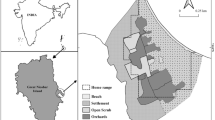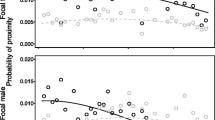Abstract
The present study investigated the influence of dominance rank in combination with kinship on age-related differences in social grooming among adult females in a free-ranging group of Japanese monkeys (Macaca fuscata). Eighty-three adult females were divided into six sub-groups according to age-class (younger: 5–9 years old; middle: 10–14 years old; older: 15–22 years old) and dominance rank (high and low rank). The ratio of the number of unrelated females that each female groomed to the total number of available unrelated females and grooming bouts which she gave to unrelated females decreased with increasing age for both high- and low-ranking females, whereas age did not appear to affect corresponding values for related females. On the other hand, compared with low-ranking females, high-ranking females of all age-classes received grooming more often from a larger number of unrelated females. Moreover, older females of low rank received grooming less often from a smaller number of unrelated females than younger females of low rank. These results indicate that with increasing age females are more likely to concentrate on related females when they have grooming interactions with other females. This tendency seems to be more apparent for low-ranking females. Moreover, the present findings also indicate that older high-ranking females could maintain their social attractiveness as high as younger high-ranking females.



Similar content being viewed by others
References
Aureli F, Das M, Veenema HC (1997) Differential kinship effect on reconciliation in three species of macaques (Macaca fascicularis, M. fuscata, and M. sylvanus). J Comp Psychol 111:91–99
Cooper MA, Bernstein IS (2000) Social grooming in Assamese macaques (Macaca assamensis). Am J Primatol 50:77–85
Dunbar RIM (1996) Grooming, gossip and the evolution of language. Farber and Faber, London
Gouzoules S, Gouzoules H (1987) Kinship. In: Smuts BB, Cheney DL, Seyfarth RM, Wrangham RW, Struhsaker TT (eds) Primate societies. University of Chicago Press, Chicago, Ill., pp 299–305
Henzi P, Barrett LB (1999) The value of grooming to female primates. Primates 40:47–59
Itoigawa N (1982) Aging and behavior in Japanese monkeys (in Japanese). Jpn J Ethnol 46:376–389
Itoigawa N, Tanaka T, Ukai N, Fujii H, Kurokawa T, Koyama T, Ando A, Watanabe Y, Imakawa S (1992) Demography and reproductive parameters of a free-ranging group of Japanese macaques (Macaca fuscata) at Katsuyama. Primates 33:49–68
Kato E (1999a) Effects of age, dominance and seasonal changes on proximity relationships in female Japanese macaques (Macaca fuscata) in a free-ranging group at Katsuyama. Primates 40:291–300
Kato E (1999b) Social isolation in aged Japanese monkeys of a free-ranging group (in Japanese). Ph. D. dissertation, Osaka University, Osaka
Keverne EB, Martensz N, Tuite B (1989) Beta-endorphin concentrations in cerebrospinal fluid of monkeys are influenced by grooming relationships. Psychoneuroendocrinology 14:155–161
Koyama N (1967) On dominance rank and kinship of a wild Japanese monkey troop in Arashiyama. Primates 8:189–216
Koyama N (1991) Grooming relationships in the Arashiyama group of Japanese monkeys. In: Fedigan LM, Asquith PJ (eds) The monkeys of Arashiyama: thirty-five years of research in Japan and the West. State University of New York Press, Albany, N.J., pp 211–226
Koyama N, Takahata Y, Huffman MA, Norikoshi K, Suzuki H (1992) Reproductive parameters of female Japanese macaques: thirty years data from the Arashiyama troops, Japan. Primates 33:33–47
Lindburg DG (1973) Grooming. In: Carpenter CR (ed) Behavioral regulators of behavior in primates. Bucknell University Press, Lewisburg, Pa., pp 124–148
Matheson MD, Bernstein IS (2000) Grooming, social bonding, and agonistic aiding in rhesus monkeys. Am J Primatol 51:177–186
Mitani M (1986) Voiceprint identification and its application to sociological studies of wild Japanese monkeys (Macaca fuscata). Primates 27:397–412
Muroyama Y (1994) Exchange of grooming for allomothering in female patas monkeys. Behaviour 128:103–119
Nakamichi M (1984) Behavioral characteristics of old female Japanese monkeys in a free-ranging group. Primates 25:192–203
Nakamichi M (1991) Behavior of old females: comparisons of Japanese monkeys in the Arashiyama East and West groups. In: Fedigan LM, Asquith PJ (eds) The monkeys of Arashiyama: thirty-five years of research in Japan and the West. State University of New York Press, Albany, N.Y., pp 175–193
Nakamichi M (1996) Proximity relationships within a birth cohort of immature Japanese monkeys (Macaca fuscata) in a free-ranging group during the first four years of life. Am J Primatol 40:315–325
Nakamichi M, Shizawa Y (2003) Distribution of grooming among adult females in a large, free-ranging group of Japanese monkeys (Macaca fuscata). Int J Primatol 24:607–625
Nakamichi M, Itoigawa N, Imakawa S, Machida S (1995) Dominance relations among adult females in a free-ranging group of Japanese monkeys at Katsuyama. Am J Primatol 37:241–251
Noe R, Hammerstein P (1995) Biological markets. Tree 10:336–340
Oki J, Maeda Y (1973) Grooming as a regulator of behavior in Japanese macaques. In: Carpenter CR (ed) Behavioral regulators of behavior in primates. Bucknell University Press, Lewisburg, Pa., pp 149–163
Pavelka MSM, Gillespie MW, Griffin L (1991) The interacting effect of age and rank on the sociability of adult female Japanese monkeys. In: Fedigan LK, Asquith PJ (eds) The monkeys of Arashiyama: thirty-five years of research in Japan and the West. State University of New York Press, Albany, N.Y., pp 194–207
Rapp PR, Amaral DG (1991) Recognition memory deficits in a subpopulation of aged monkeys resemble the effects of medial temporal lobe damage. Neurobiol Aging 12:481–486
Rowell TE (1966) Hierarchy in the organization of a captive baboon group. Anim Behav 14:430–443
Sade DS (1965) Some aspects of parent-offspring and sibling relations in a group of rhesus monkeys, with a discussion of grooming. Am J Phys Anthropol 23:1–18
Sambrook TD, Whiten A, Strum SC (1995) Priority of access and grooming patterns of females in a large and small group of olive baboons. Anim Behav 50:1667–1682
Seyfarth RM (1977) A model of social grooming among adult female monkeys. J Theor Biol 65:671–698
Silk JB (1982) Altruism among female Macaca radiata: explanations and analysis of patterns of grooming and coalition. Behaviour 79:162–188
Takahata Y (1982) Social relations between adult males and females of Japanese monkeys in the Arashiyama B troop. Primates 23:1–23
Tanaka I, Takefushi H (1993) Elimination of external parasites (lice) is the primary function of grooming in free-ranging Japanese macaques. Anthropol Sci 101:187–193
Thierry B (2000) Covariation of conflict management patterns in macaque societies. In: Aureli F, de Waal FBM (eds) Natural conflict resolution. University of California Press, Berkeley, Calif., pp 106–128
Veenema HC, Spruijt BM, Gispen WH, van Hooff JARAM (1997) Aging, dominance history and social behavior in Java-monkeys (Macaca fascicularis). Neurobiol Aging 18:509–515
Veenema HC, van Hooff JARAM, Gispen WH, Spruijt BM (2001) Increased rigidity with age in social behavior of Java-monkeys (Macaca fascicularis). Neurobiol Aging 22:273–281
Waal FBM de (1997) The chimpanzee's service economy: food for grooming. Evol Human Behav 18:375–386
Walters JR, Seyfarth RM (1987) Conflict and cooperation. In: Smuts BB, Cheney DL, Seyfarth RM, Wrangham RW, Struhsaker TT (eds) Primate societies. University of Chicago Press, Chicago, Ill., pp 306–317
Watanabe K (1979) Alliance formation in a free-ranging troop of Japanese macaques. Primates 20:459–474
Acknowledgements
The present research was supported in part by a Grant-in-Aid for General Scientific Research (11610078) to M.N. from the Ministry of Education, Science and Culture, Japan. I would like to thank Drs. N. Masataka and J. Manson for their useful comments on an earlier draft and the staff of the Laboratory of Ethological Studies, Faculty of Human Sciences, Osaka University, for their help and encouragement throughout the present research.
Author information
Authors and Affiliations
Corresponding author
About this article
Cite this article
Nakamichi, M. Age-related differences in social grooming among adult female Japanese monkeys (Macaca fuscata). Primates 44, 239–246 (2003). https://doi.org/10.1007/s10329-003-0036-x
Received:
Accepted:
Published:
Issue Date:
DOI: https://doi.org/10.1007/s10329-003-0036-x




